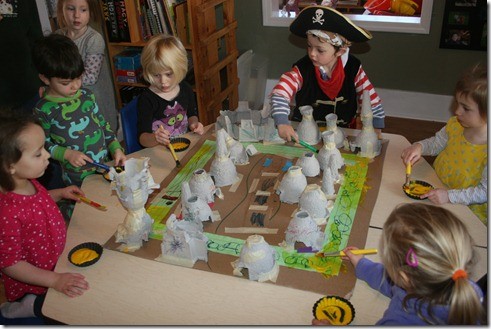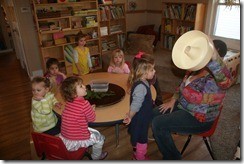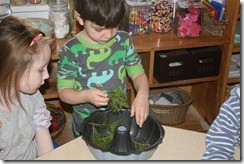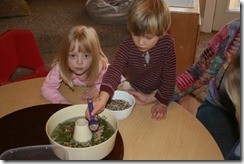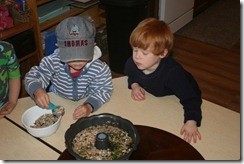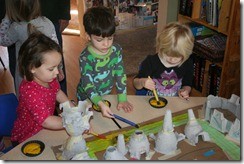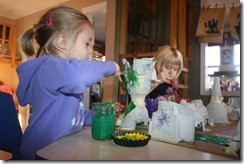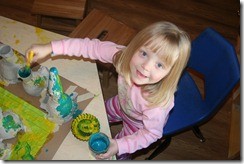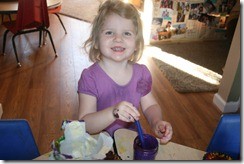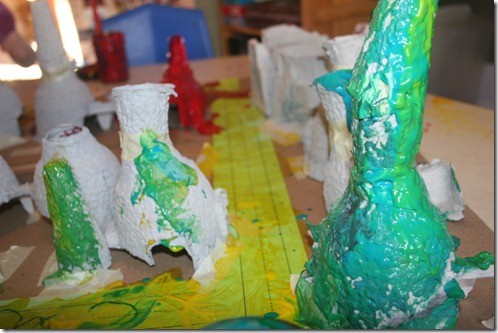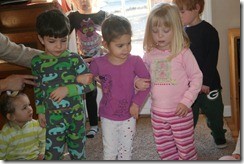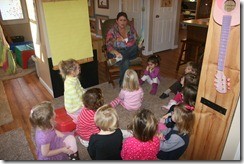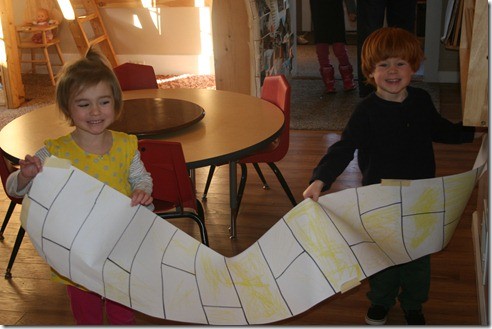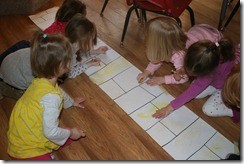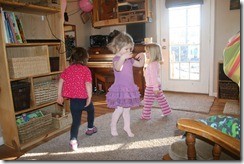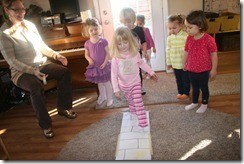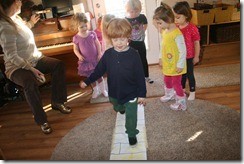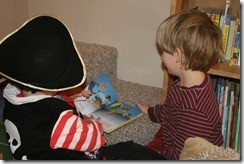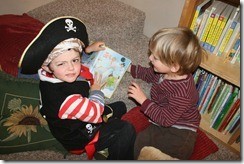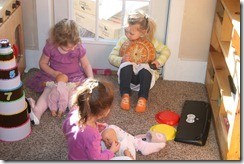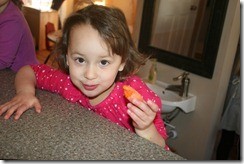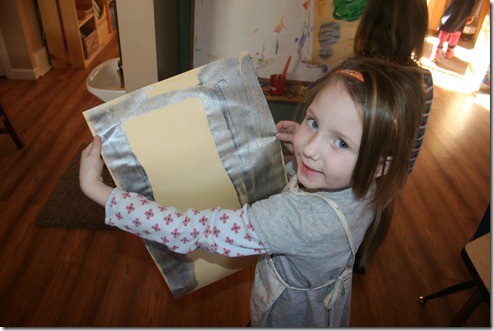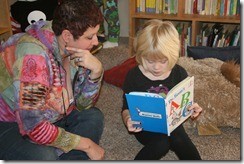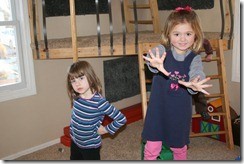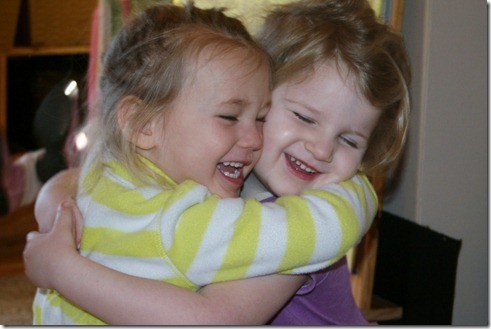This is a question that was asked earlier this week and it is one that has been asked over and over throughout the years. Every time a parent asks a question, and we answer it, we then huddle together as a teaching staff and reflect on our practice. Is our practice still relevant? Is it working? Why DO we do it that way? We value your questions because they keep us on our toes. Without those questions we lose opportunities to question, reflect, and respond. So bring them on!
So for today, I wanted to share a few very recent examples of our philosophy in action and then share our discussion about why it’s ok with us if a child opts to do their own thing instead of choosing to join a large or small group activity.
Earlier in the week, Miss Laurie created a 3D neighborhood project and invited the children in small groups to come and join her at the art table. The reply by one child was, “But I don’t want to do that”. He wanted to go to the workshop and create a train. And he did, indeed, go and create a train. And there was a teacher offering him one-to-one support to build his train. And we know that while he was at the workshop, he was intrinsically motivated to give his all to that work. Best practices are to provide him the materials and support to build his train. And we did. And he built a train that day.
Still this week, a younger child moved into group, then out of group as her interest waxed and waned. However, from the other side of the house, as soon as the group of children started singing, she moved her body back to the group and joined in enthusiastically. She was clearly paying attention to the group, even while she busied herself with her own interests. When she came to the group time, she wanted to be in the group. When children want to be there, it is a powerful tool in having a positive, structured group time.
Today, the teachers walked through Wee Friends and invited friends to join them in a sensory/science project of making Ice Wreaths to share with our birds (Thanks Jennifer and Lindsay for the idea and materials!) All of the children chose to come to the table. They all wanted to be there and they stayed and they cooperated for the duration.
Later in the morning, our 3D neighborhood project re-emerged to get its next layer of finish. Some of the children eagerly grabbed paint brushes and went to town (excuse the pun). Others continued their work in other parts of the classroom and then joined. Others declined to join in this morning, but may choose to work on it later. All of that is ok because when they are at the table they are fully invested.
So, back to the question, “Why don’t we make them come to circle time?”:
- We offer an environment full of choices (academic, social/emotional, creative, and physical), but we allow the child to choose what choices they make.
- Building focus and attention is a prime goal. What they are doing at the moment is the most important thing and the teachers are there to support and extend the play. Not to interrupt it because we are arrogant and believe our agenda is more important than what they are learning in their moment. http://oregonstate.edu/ua/ncs/archives/2012/aug/preschool-children-better-attention-spans-more-likely-finish-college
- Children learn when they are interested in what is being taught. Otherwise, just watch them in a large group situation with all of the large group distractions: they pick their noses, they pick at their friends, they squirm, they look around everywhere. Until they are about 4.5 years old and then something happens. Then, we find that they are sponges and they really want to know EVERYTHING we can tell them about EVERYTHING. Force it on them sooner and they have closed the door at 4.5 years rather than swinging it wide open for us. Research backs this….http://www.msnbc.msn.com/id/20056147/ns/health-childrens_health/t/should-preschools-teach-all-work-no-play/
- Children learn when they are ready for what is being taught. Were you one of those children that they tried to teach algebra in 7th grade and you just didn’t get it? I was. I was an awesome student and no matter how hard they tried and I tried, it didn’t make sense. Until it did, later, when my brain was ready. Reading concepts for children are the same thing. We immerse them in literacy (stories aloud individually and in small groups, daily writing opportunities, modeling writing, teachers always available for conversations that build language, music that utilizes rhythm and rhyme, learning materials that support literacy, etc) We give them the pieces of the puzzle and when their brains are ready it clicks. It always does. The article below states, “Most children learn to read by 6 or 7 years of age. Some children learn at 4 or 5 years of age.” We know this to be true. http://www.healthychildren.org/English/ages-stages/preschool/pages/Helping-Your-Child-Learn-to-Read.aspx?nfstatus=401&nftoken=00000000-0000-0000-0000-000000000000&nfstatusdescription=ERROR%3a+No+local+token
- Children learn the concepts when they are working on something else nearby. We see this over and over when they talk to us about what they heard at the perimeter of the circle.
- Circle time is the least effective direct teaching that we do. That individual conversation that a teacher has with a child is also direct teaching and it is the most effective. But, that’s another whole blog in itself.
- Wee Friends honors the individual child, their individual development, and their individual interests. Through this, we cultivate a lifelong love of learning.
So really, it’s more than ok with us that our Wee Frienders can opt out of a group time. At the core, we know it is a gift we are giving the children. We know that we are offering a gazillion opportunities for small group times and large group times and we trust that the children know which ones will be valuable to them.
Have a great day!
Tami
Breakfast today was Kix and Banana. Wee Sprouts were baby carrots. For lunch, we had whole wheat flat bread filled with cream cheese and turkey, fresh cauliflower/cucumbers, and fresh mango/bananas.

